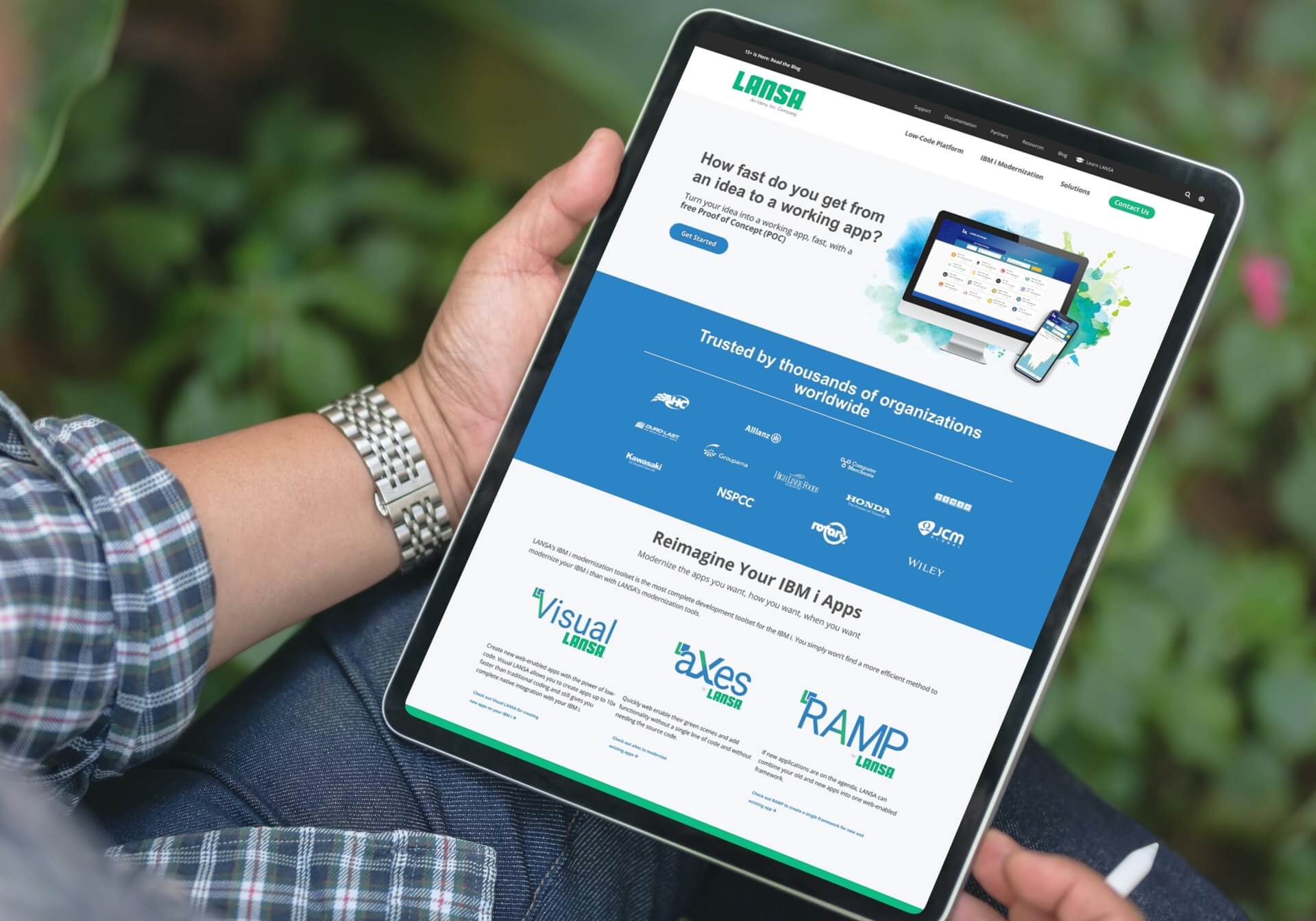It’s been more than 11 years since Paul Conte, a reputable application development strategist, formulated the main lessons of IBM application modernization. Summarizing the knowledge gained during the initial legacy business app modernization boom, he came up with ten reasons why these projects fail.
Back then, most problems with IBM application modernization derived from misunderstanding the concept of modernizing legacy business apps or simply approaching this in a careless and rushed manner, lacking qualified talent, tools, and field knowledge.
What’s the state of IBM application modernization in 2022?
The world is not standing still, the tech world especially, and we can probably say that many things have changed since 2011. Business leaders are much more informed about enterprise IT. IBM application modernization didn’t go anywhere, however, and remains relevant in the 2020s business environment.
Thousands of organizations around the globe are still in the process of updating the old IBM AS/400 legacy, or fixing and rebuilding the results of previous app modernization attempts.
Just like in 2011, it’s not that uncommon for companies to go through a series of failures or challenging issues when trying to finally modernize all parts of their IBM i infrastructure. This is largely due to the same underlying reasons as well.
Why do IBM application modernization projects fail?
But you can’t look at IBM application modernization from the same 2011 point of view today. Following is an updated list of the most common and frequently observed reasons why business app modernization projects fail in 2022.
Failing to encompass all aspects of IBM application modernization
We can’t deny that significant and undeniable progress has been made since 2011 in terms of modernization-related knowledge in the business environment. The most fundamental problem is the failure to grasp the concept of business application modernization.
Most organizations today realize that IBM application modernization is much more than simply changing an old green-screen interface to a new one. They know you have to also address legacy RPG code, fix outdated business logic, and redeploy IBM i apps to modern host environments.
At the same time, we can’t say that the perception of app modernization as a concept among IT leaders and business managers has evolved that much. So, it is typical to have a situation where those executing IBM application modernization on different levels across organizational structures have vastly different levels of understanding. This can create a disconnect.
Crooked legacy code modernization
Updating legacy RPG programming language code, or refactoring, is one component of IBM application modernization that seems to remain consistently problematic. Many automatic tools that transfer original RPG code into modern object-oriented languages often fail to provide value.
Refactoring is probably the second most common strategy organizations use as part of their application modernization projects nowadays. Refactoring involves changing the original programming code of legacy business applications to restructure and optimize it. It also includes removing parts that are not functional and eliminating technical debt.
Simply translating RPG code into Java or any other modern language is a task that most automated tools can handle. However, this alone hardly ever resolves any of the related issues. In most cases, a code refactoring solution keeps the same structure and volume of code as in the original app.
As a result, the code still keeps most of the legacy-related qualities, even though technically IBM legacy code modernization has been implemented.
Overreliance on re-hosting and re-platforming
It’s quite natural that re-hosting and re-platforming, also known as lift-and-shift scenarios, are among the most widely implemented modernization strategies. This is because they are among the most simple, easy to implement, and risk-free methods.
In re-hosting, organizations simply redeploy all the application components—its code, features, and functions—to other hosting environments without any modifications. Re-hosting typically means shifting the app from legacy on-premise hosting infrastructure to a public cloud or into a container on a new runtime (re-platforming) when it comes to legacy business application modernization strategies.
Re-platforming can be a great initial solution to protect IT infrastructure from performance, data loss, and security risks associated with relying on outdated on-premise hosting platforms. But it also solves only one legacy-related issue. Companies that just implement re-hosting or re-platforming and call it modernization often realize it’s a mistake soon enough.
Challenges establishing version updates and cross-platform deployment
Another major mistake is generally overlooking all the aspects of IBM application modernization that come after the solution has been implemented. This is why some companies face the most challenging issues when it comes to version updating deployment of new apps.
Since business apps need to support all major platforms – desktops, and mobile – in the modern-day environment, deploying modernized apps to each one of them isn’t always a success. Suppose the support of some platforms turns problematic. In that case, it also means that version updating will be a problem as well.
What is the key to successfully completing IBM application modernization?
Thus, the underlying reasons for the failed IBM application modernization are the same as they were ten years ago. But having over a decade of experience, we are able to see and describe them from a different angle.
The approach to fixing all these and other modernization mistakes is the same as well. However, the tools and solutions by LANSA have evolved quite a bit over the years. They now encompass a selection of advanced solutions designed for fixing IBM application modernization mistakes. All this is an addition to the Visual LANSA platform that utilizes the increasingly popular low-code approach to development.
Visual LANSA
Visual LANSA is a low-code, rapid application development platform for building enterprise-grade mobile, web, and desktop apps. LANSA’s platform has been a key component powering the successful delivery of IBM modernization projects for hundreds of organizations throughout the years. Utilizing Visual LANSA allows organizations of all sizes to use their existing development resources to build new apps. It also aids users to integrate their apps with other parts of their IT systems.
Visual LANSA enables easy IBM app modernization by simplifying this process as much as possible. It also minimizes the need to have technical skills in order to complete an app development project.
The arsenal of development instruments and features offered by LANSA include several tools that were created for the IBM i platform exclusively. The modernization of IBM i apps and related systems are then accessible to any business.
RAMP (Rapid Application Modernization Process)
Rapid Application Modernization Process (RAMP) is an incremental modernization approach that implements the best of refacing existing applications and new development. You can consolidate existing functionality with new capabilities inside RAMP’s application framework. With this, you get the applications you want without having to throw everything away. Modernization is performed in stages. New functionality can be introduced incrementally without serious impact on business operations. With this, the user interface becomes consistent across all the applications.
aXes
One of LANSA’s solutions created for IBM i users specifically is aXes, a tailor-made tool designed to automate the creation of web-enabled IBM i applications. It allows organizations to easily transform their existing IBM i 5250 apps into web pages out-of-the-box without changing source code.
aXes includes an API that allows developers to create programs able to operate applications written with RPG or COBOL automatically. Additionally, applications can use aXes to simulate a person’s actions entering data on screens in an IBM i application.
100% free guide to IBM application modernization
Want to catch up on IBM application modernization knowledge?
Modernization is an overwhelming process that can either make or break your company. That’s why planning and strategizing for IBM modernization is so important. We combined all the fundamental knowledge about enterprise app modernization in one white paper titled “Application Modernization For Dummies, LANSA Edition.” You can download it for free on this page.
Who can fix all your IBM modernization issues?
LANSA’s platform combines all the right trends in modern-day software development and digital transformation. This helps organizations succeed in IBM application modernization. LANSA’s solutions have been used by companies of all sizes and across industries for more than three decades.
Not sure if LANSA’s tools meet all your business requirements? You can get a free Proof of Concept (POC) implemented by LANSA based on your input data. Just fill-up the form on our website.
Ready to begin? Get in touch with us to start utilizing Visual LANSA for your app development and modernization needs.








